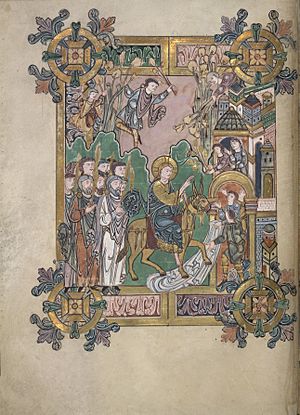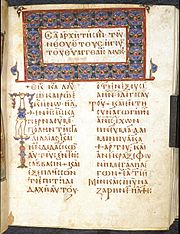Regularis Concordia (Winchester) facts for kids
The Regularis Concordia was a super important document for a big religious change in England called the English Benedictine Reform. It was officially approved around the year 973 by a meeting in Winchester.
This document was put together by a monk named Æthelwold. He got help from other monks from places like Fleury and Ghent. A special meeting was called to create a common set of rules for all monasteries to follow. The document explained how monks and nuns should live their lives. It even included rules for choosing bishops, which was different from other parts of Europe. This led to many bishops in England being monks themselves!
Contents
What Was Inside?
One of the main parts of the document was called the Forward to the Harmony of the Rule. This part was meant for all the monks and nuns in England, under King Edgar. It said that every religious house in the kingdom had to follow the rules in the rest of the document.
This included how to perform the monastic "office." The "office" means daily prayers and services like vigils and lauds, which have been done since the 400s. The rules for these services were very detailed. For example, they even said what specific songs should be sung during the hours when monks were required to work.
The Regularis Concordia also had very detailed instructions for the rituals during Holy Week and Easter. This is where something called the quem quaeritis was first described. People now believe this was the very beginning of theatrical performances in churches! The document also set out specific ways that bells should be rung for Masses and holidays.
A Time of Change: Historical Background
Under Edgar the Peaceful (who ruled from 959 to 975), England had a time of peace. This period also saw a big comeback for monasticism, which is the way of life for monks and nuns. Æthelwold of Winchester improved and expanded the Rule of Saint Benedict. He then wrote the Regularis Concordia because of King Edgar's support for this religious revival.
Monastic Reform in the 900s
The need for monastic reform became urgent in the mid-900s when the Rule of Saint Benedict became very popular. People who supported this reform, like King Edgar, Æthelwold of Winchester, Dunstan, and Oswald of Worcester, believed that monasticism had almost disappeared in the 800s. They thought The Rule of Saint Benedict was the key to bringing it back to life. They saw this text as the perfect way for monks and nuns to live and follow a uniform way of life.
Key Leaders: Æthelwold
Æthelwold of Winchester is known as the main person who wrote the original Regularis Concordia. This document became an official part of the monastic reform in Anglo-Saxon England in the 900s. Æthelwold was also the only person to translate the Rule of Saint Benedict into English, and this translation was included in the Regularis Concordia.
He was a great leader for the English Benedictine Reform. People said he was "as terrible as a lion" to those who didn't follow the rules. He was also very passionate about fighting corruption in the church. Æthelwold successfully brought the monastic practices from France to Southern England.
Key Leaders: Dunstan
Dunstan was an abbot at Glastonbury and is thought to have been a mentor to Æthelwold. Dunstan was responsible for starting a monastic revival in his own monastery. He created a set of religious rules that eventually spread and led to the wider revival in the 900s. He even removed corrupt church leaders from his monastery, even though he faced threats. Dunstan became a symbol of good morals in his community. This image helped him have a big impact on the overall revival.
The First Play: Theatrical Ritual
The earliest example of a theatrical ritual comes from the Regularis Concordia. It's found in the rules for a divine service called the quem quaeritis. This rule describes the oldest known theatrical performance. It was an alternating song performed the night before Easter. The Regularis Concordia said that this visual ritual was important. It helped people who couldn't read or understand Latin to understand the religious ceremony.
The Latin words below describe it: "An alternating song between the three women approaching the grave, and the angel watching on it, shall be recited; the friar who sings the words of the angel is to take his seat, clad in an alb and with a palm-twig in his hand, in a place representing the tomb; three other friars, wearing hooded capes and with censers in their hands, are to approach the tomb at a slow pace, as if in quest of something"
The Latin song itself goes: Quem quaeritis in sepulchro, o Christicolae? (Whom do you seek in the tomb, O Christians?) Jesum Nazarenum cruifixum, o caelicolae. (Jesus of Nazareth, the crucified, O heavenly ones.) Non est hic, surrexit, sicut praedixerat. Ite, nuntiate, quia surrexit de sepulchro. (He is not here; he has risen, just as he foretold. Go, announce that he has risen from the tomb.)
Old Copies: Manuscripts
Dom Thomas Symons' English translation of the Regularis Concordia from 1953 used two copies that still exist today:



